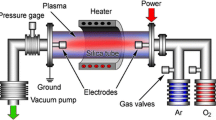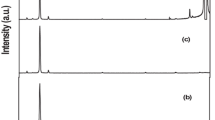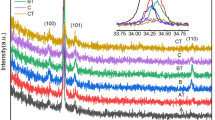Abstract
Doping of ZnO nanostructures was investigated by using a low temperature electrochemical process. Various dopant materials have been studied, including transition metals, group I, and group VII elements. The structure, composition, and optical properties of the doped ZnO nanostructures were analyzed by scanning electron microscopy, energy dispersive X-ray spectroscopy, photoluminescence, and x-ray diffraction. It was demonstrated that dopant elements were incorporated into the ZnO structures. The effects of dopant incorporation on the structure and properties of ZnO were also investigated. This low temperature approach is compatible with current micro-fabrication techniques and promising for large-scale production of doped ZnO nanostructures for optical and electronic applications.
Similar content being viewed by others
References
Sun Y, Ketterson J B, Wong G K L. Excitonic gain and stimulated ultraviolet emission in nanocrystalline zinc-oxide powder. Appl Phys Lett, 2000, 77: 2322–2324
Look D C. Recent advances in ZnO materials and devices. Mater Sci Eng B, 2001, 80: 383–387
Wu R, Yang Y, Cong S, et al. Fractal dimension and photolumines-cence of ZnO tetrapod nanowhiskers. Chem Phys Lett, 2005, 406: 457–461
Gao P X, Ding Y, Wang Z L. Crystallographic orientation-aligned ZnO nanorods grown by a tin catalyst. Nano Lett, 2003, 3: 1315–1320
Vanheusden K, Warren W L, Seager C H, et al. Mechanisms behind green photoluminescence in ZnO phosphor powders. J Appl Phys, 1996, 79: 7983–7990
Kind H, Yan H, Messer B, et al. Nanowire ultraviolet photodetectors and optical switches. Adv Mater, 2002, 14: 158
Guo Q X, Kume Y, Tanaka T, et al. Strong room-temperature UV luminescence from ZnO grown by metal organic decomposition. Jpn J Appl Phys, 2005, 44: 8451–8452
Minami T, Sato H, Nanto H, et al. Highly conductive and transparent Si-doped ZnO thin films prepared by RF magnetron sputtering. Jpn J Appl Phys, 1986, 25: L776–779
Hu J H, Gordon R G. Textured fluorine-doped ZnO films by atmophoric pressure chemical vapor-deposition and their use in amorphous-silicon solar cells. Sol Cells, 1991, 30: 437–450
Gao P X, Wang Z L. Nanoarchitectures of semiconducting and piezoelectric zinc oxide. J Appl Phys, 2005, 97: 044304
Yu S F, Yuen C, Lau S P, et al. Ultraviolet amplified spontaneous emission from zinc oxide ridge waveguides on silicon substrate. Appl Phys Lett, 2003, 83: 4288–4290
Cui J B, Gibson U J. Electrodeposition and room temperature ferromagnetic anisotropy of Co and Ni-doped ZnO nanowire arrays. Appl Phys Lett, 2005, 87: 133108
Dietl T, Ohno H, Matsukura F, et al. Zener model description of ferromagnetism in zinc-blende magnetic semiconductors. Science, 2000, 287: 1019–1022
Zhang S B, Wei S H, Zunger A. Intrinsic n-type versus p-type doping asymmetry and the defect physics of ZnO. Phys Rev B, 2001, 63: 075205
Van de Walle C G. Hydrogen as a cause of doping in zinc oxide. Phys Rev Lett, 2000, 85: 1012–1015
Cui J B, Gibson U J. Enhanced nucleation, growth rate, and dopant incorporation in ZnO nanowires. J Phys Chem B, 2005, 109: 22074–22077
Ueda K, Tabata H, Kawai T. Magnetic and electric properties of transition-metal-doped ZnO films. Appl Phys Lett, 2001, 79: 988–990
Ramachandran S, Tiwari A, Narayan J. Zn0.9Co0.1O-based diluted magnetic semiconducting thin films. Appl Phys Lett, 2003, 84: 5255–5257
Strijkers G J, Dalderop J H J, Broeksteeg M A A, et al. Structure and magnetization of arrays of electrodeposited Co wires in anodic alumina. J Appl Phys, 1999, 86: 5141–5145
Wu X L, Siu G G, Fu C L, et al. Photoluminescence and cathodoluminescence studies of stoichiometric and oxygen-deficient ZnO films. Appl Phys Lett, 2001, 78: 2285–2287
Liu M, Kitai A H, Mascher P. Point defects and luminescence-centers in zinc oxide and zinc oxide doped with manganese. J Lumin, 1992, 54: 35–42
Cui J B, Soo Y C, Chen T P, et al. Low-temperature growth and characterization of Cl-doped ZnO nanowire arrays. J Phys Chem C, 2008, 112: 4475–4579
Author information
Authors and Affiliations
Corresponding author
Rights and permissions
About this article
Cite this article
Cui, J.B., Thomas, M.A., Kandel, H. et al. Low temperature doping of ZnO nanostructures. Sci. China Ser. E-Technol. Sci. 52, 318–323 (2009). https://doi.org/10.1007/s11431-008-0353-9
Received:
Accepted:
Published:
Issue Date:
DOI: https://doi.org/10.1007/s11431-008-0353-9




